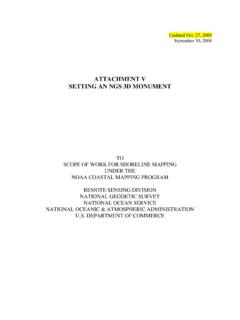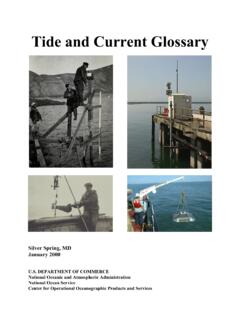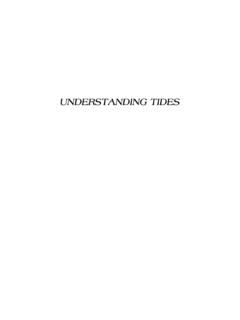Transcription of GLOBAL AND REGIONAL SEA LEVEL RISE SCENARIOS FOR THE ...
1 NOAA Technical Report NOS CO-OPS 083 noaa National Oceanic and Atmospheric Administration DEPARTMENT OF COMMERCE National Ocean Service Center for Operational Oceanographic Products and Services GLOBAL AND REGIONAL SEA LEVEL RISE SCENARIOS FOR THE UNITED STATES Silver Spring, Maryland January 2017 Photo: Ocean City, Maryland Center for Operational Oceanographic Products and Services National Ocean Service National Oceanic and Atmospheric Administration Department of Commerce The National Ocean Service (NOS) Center for Operational Oceanographic Products and Services (CO-OPS) provides the National infrastructure, science, and technical expertise to collect and distribute observations and predictions of water levels and currents to ensure safe, efficient and environmentally sound maritime commerce.
2 The Center provides the set of water LEVEL and tidal current products required to support NOS Strategic Plan mission requirements, and to assist in providing operational oceanographic data/products required by NOAA s other Strategic Plan themes. For example, CO-OPS provides data and products required by the National Weather Service to meet its flood and tsunami warning responsibilities. The Center manages the National Water LEVEL Observation Network (NWLON), a national network of Physical Oceanographic Real-Time Systems (PORTS ) in major U. S. harbors, and the National Current Observation Program consisting of current surveys in near shore and coastal areas utilizing bottom mounted platforms, subsurface buoys, horizontal sensors and quick response real time buoys.
3 The Center: establishes standards for the collection and processing of water LEVEL and current data; collects and documents user requirements, which serve as the foundation for all resulting program activities; designs new and/or improved oceanographic observing systems; designs software to improve CO-OPS data processing capabilities; maintains and operates oceanographic observing systems; performs operational data analysis/quality control; and produces/disseminates oceanographic products. NOAA Technical Report NOS CO-OPS 083 DEPARTMENT OF COMMERCE Penny Pritzker, Secretary National Oceanic and Atmospheric Administration Dr. Kathryn Sullivan, NOAA Administrator and Under Secretary of Commerce for Oceans and Atmosphere National Ocean Service Dr.
4 Russell Callender, Assistant Administrator Center for Operational Oceanographic Products and Services Richard Edwing, Director GLOBAL and REGIONAL Sea LEVEL Rise SCENARIOS for the United States William V. Sweet National Oceanic and Atmospheric Administration, Center for Operational Oceanographic Products and Services, Silver Spring, MD, USA Robert E. Kopp Department of Earth & Planetary Sciences, Rutgers Energy Institute and Institute of Earth, Ocean & Atmospheric Sciences, Rutgers University New Brunswick, New Brunswick, NJ, USA Christopher P. Weaver Environmental Protection Agency, Office of Research and Development, Research Triangle Park, NC, USA Jayantha Obeysekera South Florida Water Management District, West Palm Beach, FL Radley M.
5 Horton Center for Climate Systems Research, Columbia University Earth Institute, New York, NY, USA E. Robert Thieler Geological Survey, Woods Hole, MA, USA Chris Zervas National Oceanic and Atmospheric Administration, Center for Operational Oceanographic Products and Services, Silver Spring, MD, USA January 2017 NOTICE Mention of a commercial company or product does not constitute an endorsement by NOAA. Use of information from this publication for publicity or advertising purposes concerning proprietary products or the tests of such products is not authorized. iii TABLE OF CONTENTS LIST OF FIGURES .. IV LIST OF TABLES .. V EXECUTIVE SUMMARY.
6 VI INTRODUCTION ..1 SEA LEVEL RISE: HISTORIC INSIGHTS AND RECENT OBSERVATIONS ..7 GLOBAL MEAN SEA LEVEL CHANGES .. 8 REGIONAL SEA LEVEL CHANGES .. 9 RELATIVE SEA LEVELS .. 9 FUTURE SEA LEVELS: SCENARIOS AND PROBABILISTIC PROJECTIONS .. 11 PROBABILISTIC GMSL RISE PROJECTIONS .. 12 UPPER AND LOWER GMSL RISE SCENARIO BOUNDS .. 13 REGIONALIZATION OF THE GMSL RISE SCENARIOS .. 15 PROCESSES AFFECTING REGIONAL RSL CHANGE .. 15 REGIONALIZATION METHOD .. 15 RESULTS .. 21 GLOBAL MEAN SEA LEVEL RISE SCENARIOS .. 21 GMSL RISE RATES THIS CENTURY AND RISE BEYOND 2100 .. 22 REGIONAL CLIMATE-RELATED RSL 24 NONCLIMATIC BACKGROUND RSL AND GPS VLM TRENDS.
7 27 SCENARIO PROJECTIONS OF RELATIVE SEA LEVEL (RSL) .. 29 USAGE OF SCENARIOS WITHIN A RISK-BASED CONTEXT .. 33 GENERAL GUIDELINES FOR SCENARIO SELECTION .. 33 SCENARIO PROJECTIONS OF RSL AND TIDAL FLOOD FREQUENCIES: A NATIONAL PERSPECTIVE .. 35 BUILDING FOR A MAJOR FLOOD EVENT: A CASE STUDY FOR SOUTH FLORIDA .. 39 SUMMARY AND NEXT STEPS .. 43 ACKNOWLEDGEMENTS .. 45 REFERENCES .. 47 LIST OF APPENDICES .. 55 APPENDIX A. SEA LEVEL RISE AND COASTAL FLOOD HAZARD SCENARIOS AND TOOLS INTERAGENCY TASK FORCE .. A-1 APPENDIX B. LOW AND HIGH CLIMATE-RELATED RSL CHANGE CORRESPONDING TO GMSL SCENARIOS .. B-1 APPENDIX C. LOW AND HIGH TOTAL RSL CHANGE CORRSPONDING TO GMSL SCENARIOS .
8 C-1 APPENDIX D. CMIP5 MODELS USED .. D-1 ACRONYMS .. iv LIST OF FIGURES Figure 1. a) Multi-year empirical (smoothed) distributions for daily highest water levels in Norfolk, Va. (Sweet and Park 2014) for the 1960s and 2010s, showing extent that local RSL rise has increased the flood probability relative to impact thresholds defined locally by the National Weather Service ( ) for minor (~ m: nuisance LEVEL ), moderate (~ m) and major (~ m: local LEVEL of Hurricane Sandy in 2012) impacts, relative to mean higher high water (MHHW) tidal datum of the National Tidal Datum Epoch (1983-2001). b) Due to RSL rise, annual flood frequencies (based upon 5-year averages) in Norfolk for recurrent nuisance tidal floods with minor impacts are accelerating, as shown by the quadratic trend fit (goodness of fit [R2]= ).
9 Flood rates are rapidly increasing in similar fashions along dozens of coastal cities of the ( , Sweet et al., 2014; Sweet and Park, 2014; Sweet and Marra, 2016).. 2 Figure 2. Schematic showing the intersection of scenario approaches with emission-dependent (conditional) probabilistic projections of sea LEVEL rise under the climate modeling community s Representative Concentration Pathways (RCP) (van Vuuren et al., 2011).. 4 Figure 3. a) GMSL rise from -500 to 1900 CE from Kopp et al. (2016a) s geological and tide gauge-based reconstruction [black line with blue error estimates], from 1900 to 2010 from Hay et al. (2015) s tide gauge-based reconstruction [black], and from 1992 to 2015 from the satellite-based reconstruction updated from Nerem et al.
10 ( 2010 ) [magenta] and b) comparisons of GMSL since 1992 from NOAA/NESDIS/STAR (black line) and the summation (purple line) of GLOBAL mean ocean mass from GRACE (blue line) and steric (density) sea LEVEL from Argo (red line) with seasonal variations removed and 60-day smoothing applied (from Leuliette and Nerem, 2016).. 8 Figure 4. a) Sea LEVEL change rates from 1992-2016 from TOPEX/Poseidon, Jason-1 and Jason-2 ( ) and b) relative sea LEVEL trends based upon full record (>30-year period of record in all cases) measured and published for NOAA tide gauges through 2015 ( ).. 9 Figure 5. VLM trend estimates (mm/year) derived from GPS platforms used by Hall et al.



